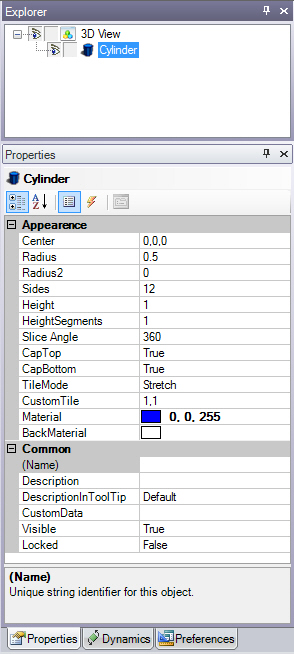The 3D Cylinder Primitive
Use the ![]() cylinder object to create a wheel, a post, or a rounded leg. You can also use it to create a
cylinder object to create a wheel, a post, or a rounded leg. You can also use it to create a ![]() tube-like shape or a 3D arch; however, keep in mind that when you create a tube you add an inner radius that has vertices that take up additional space in your 3D display. If you don't need to expose the inner workings of a tube, then using a cylinder is the more economical choice.
tube-like shape or a 3D arch; however, keep in mind that when you create a tube you add an inner radius that has vertices that take up additional space in your 3D display. If you don't need to expose the inner workings of a tube, then using a cylinder is the more economical choice.
|
|
Tip: If you are creating pipes, 3D pipe primitive is a better tool to use than the cylinder primitive. |
You can change modify a cylinder in the 3D viewport by using the manipulator icons, but you can also manipulate it by changing its properties. Default property values for cylinders are set in the Preferences tab, in the New Cylinder Default Settings.
You can add a cylinder to your 3D view by clicking the cylinder 
-
Add a Cylinder primitive to your 3D view by clicking the cylinder icon in the of the Home ribbon. The Cylinder will appear in your 3D view, and you will see it listed in the
 Explorer and the Properties tab.
Explorer and the Properties tab. -
Use the tools in the Home ribbon's Manipulator section to change the shape, size, and orientation of the cylinder; this is easier than using the cylinder's properties to do the same.
-
Use the cylinder's properties to make other changes to the cylinder. Many of the cylinder's properties are described in Common Properties for All 3D Primitives.
-
If you are creating a tube, use the cylinder's Radius2 property.
 Click here for an example.
Click here for an example. -
To survey the 3D display, use the tools described in Navigating in a 3D Viewport and the perspective buttons described in View Section of the 3D Home Ribbon.
|
|
Note: You can |
You can:
Add a dynamic from the Dynamic ribbon
Move, scale, rotate, transform, or duplicate the cylinder
Change the look (color, texture..)
See also:





